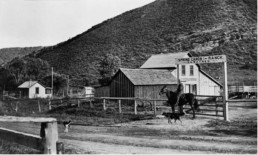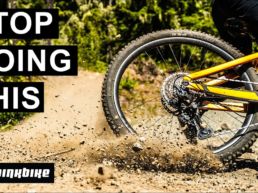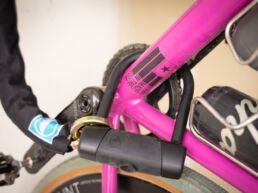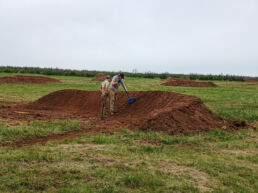In the following article, Reno Toffoli discusses how to safely ride near equestrians on our local trails. You can read Reno’s full article on trail etiquette here.

Equestrians get their own rules, and they’re really pretty simple. Horses are herbivores, and they think that everything wants to eat them. Because of that, they’re skittish, and they don’t like big loud things that move quickly.
Here’s the deal with equestrians: If you see horses up ahead (whether you want to overtake them or pass them going the opposite direction), stop where the rider can see you and announce your presence. Do this at a considerable distance if at all possible.
If you are coming up behind a group of equestrians and want to overtake them, here’s what to do after you’ve made initial contact with them: Give the rider time to respond and position their horse. They will probably want to get off the trail and turn the horse so it can see you. Some may want to dismount the horse. Only proceed to pass the equestrian when the rider has given you the ok. Usually, once they get the horse where they want it, they’ll tell you to come through. Ride very slowly past the equestrians, and everything should be all right. If a horse spooks when you go by, I’ve always just stopped and waited for the rider to get control again. They should tell you when it’s safe to proceed. Put a little distance between you and the equestrians before you resume full pace, just for insurance.
If you are passing equestrians head-on (going in opposite directions), once you’ve stopped and made initial contact, you may just be able to stand by the side of the trail and let them pass. The rider may take the horse off trail and wide around you, or they may come right up the trail next to you if there’s no room to go wide. Give them as much space as you can and keep cool as they go by. Horses scare me, so I’m pretty careful around them. I don’t make any sudden moves or dig through my backpack or anything like that. I don’t really expect herbivores to be predictable, so I’m always prepared for the worst. Once the equestrian(s) get by you, give them a little distance before you ride away. Horses don’t like weird things going on behind them. If you try to take off the instant a horse clears you and it hears your shoe snap into the pedal or just the crunch of gravel from your tires, it can spook. Let them get 50-100 feet down the trail before you resume.
Things not to do when approaching equestrians: Don’t bear down on them and stop at the last second; that’s a great way to spook and injure a horse, a rider, or yourself. Don’t ride behind a horse; that’s a great way to spook the horse and get kicked. Never try to pass an equestrian unannounced! That will not be a happy ending.
Tips
- Yield to horses. Mountain bikers should always yield to horses on the trail.
- Announce your presence. When approaching a horse, let the rider know you are there by saying hello or using a bell.
- Slow down or stop. If the rider requests it, slow down or stop to allow the horse to pass safely.
- Maintain a safe distance.
- Follow the rider’s instructions. If the rider gives you instructions on how to pass safely, follow them.
- Avoid sudden movements or loud noises. These can startle the horse.
- Be aware of your surroundings. Pay attention to blind corners and other trail users.
- If you are unsure how to proceed, ask the rider.
- If possible, pull to the downhill side of the trail. Horses tend to perceive threats on the uphill side as predators.
- Speak to the rider and horse in a friendly and relaxed tone. This can help to reassure the horse that you are not a threat.
- Remove your helmet if it obscures your face. This will help the horse to recognize you as a human.
- If you are approaching horses from behind, stop and call ahead to let the rider know.
- When passing horses, do so at a slow and steady pace. Avoid making any sudden movements or sounds that might startle the horse.
When in doubt, stop and talk to both the rider and the horse. Nobody wants to see someone get bucked off and hurt.






